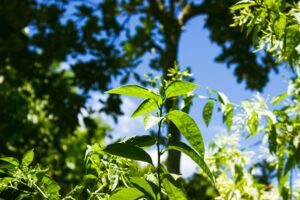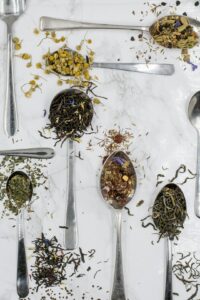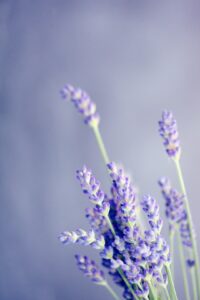Support our educational content for free when you purchase through links on our site. Learn more
[2023] List of Plants That Like Tea Leaves: Boost Your Garden’s Health
Quick Answer:
Tea leaves are not only great for brewing a soothing cup of tea, but they can also benefit your garden by enriching the soil and providing essential nutrients. Many plants thrive when tea leaves are used as a natural fertilizer or added to compost. Some plants that particularly enjoy tea leaves include roses, hydrangeas, ferns, and acid-loving plants like azaleas and rhododendrons. However, it’s important to note that not all plants are fond of tea leaves, so it’s essential to know which ones to avoid. Read on to discover the plants that love tea leaves and those that don’t, along with some quick tips and facts to help you make the most of this natural garden booster.
Table of Contents
- Quick Answer
- Quick Tips and Facts
- Using Tea Leaves in the Garden
- Using Tea Leaves in Compost
- Using Tea Leaves for Acid-Loving Plants
- Using Tea Leaves to Prevent Weeds
- Using Tea Leaves to Deter Pests and Insects
- Using Tea Leaves to Prevent Fungus
- Which Plants Like Used Tea Leaves?
- Which Plants Don’t Like Used Tea Leaves?
- FAQ
- Conclusion
- Recommended Links
- Reference Links
Quick Tips and Facts
- Tea leaves are rich in nutrients such as nitrogen, potassium, and phosphorus, making them an excellent natural fertilizer for plants.
- Used tea leaves can be added directly to the soil or used in compost to improve its structure and fertility.
- Tea leaves can help deter pests and insects, prevent weed growth, and even protect plants from fungal diseases.
- Acid-loving plants like azaleas, rhododendrons, and blueberries benefit greatly from the acidity of tea leaves.
- Not all plants like tea leaves, so it’s important to know which ones to avoid using them on.
Using Tea Leaves in the Garden
Tea leaves can be a valuable addition to your garden, providing essential nutrients and improving soil health. Here are some ways you can use tea leaves in your garden:
-
Direct Application: Sprinkle used tea leaves around the base of plants, avoiding direct contact with the stems. This will slowly release nutrients into the soil as the tea leaves decompose.
-
Compost: Add tea leaves to your compost pile to enhance its nutrient content and improve the structure of the compost. Tea leaves are considered “green” compost material and should be balanced with “brown” materials like dried leaves or straw.
-
Mulch: Spread a layer of tea leaves around plants as a natural mulch. This will help retain moisture, suppress weed growth, and gradually release nutrients into the soil.
-
Liquid Fertilizer: Create a tea leaf-infused liquid fertilizer by steeping used tea leaves in water for a few days. Strain the liquid and use it to water your plants. This provides an immediate nutrient boost.
Using tea leaves in the garden can benefit a wide range of plants, but it’s important to know which ones are particularly fond of tea leaves.
Using Tea Leaves in Compost
Composting is an excellent way to recycle kitchen and garden waste while creating nutrient-rich soil amendment. Tea leaves are a valuable addition to the compost pile, as they provide essential nutrients and help speed up the decomposition process. Here’s how you can use tea leaves in compost:
-
Balance: Tea leaves are considered “green” compost material, rich in nitrogen. To create a balanced compost, mix tea leaves with “brown” materials like dried leaves, straw, or shredded paper. Aim for a ratio of roughly 1 part tea leaves to 3 parts brown material.
-
Layering: Alternate layers of tea leaves with other compost materials to ensure proper aeration and decomposition. This helps prevent the compost from becoming too compacted or smelly.
-
Moisture: Tea leaves can absorb moisture, so it’s important to maintain the right moisture level in your compost pile. If the pile becomes too dry, add water. If it becomes too wet, add more dry materials like leaves or straw.
-
Turning: Regularly turn your compost pile to promote decomposition and prevent odors. This helps distribute the tea leaves and other compost materials evenly.
Using tea leaves in compost not only enriches the nutrient content but also improves the overall quality of the compost.
Using Tea Leaves for Acid-Loving Plants
Some plants thrive in acidic soil conditions, and tea leaves can help create the ideal environment for these acid-loving plants. Here are a few plants that benefit from the acidity of tea leaves:
-
Azaleas: Azaleas are stunning flowering shrubs that prefer acidic soil. Adding tea leaves to the soil around azaleas can help maintain the desired pH level and provide a slow-release source of nutrients.
-
Rhododendrons: Rhododendrons, like azaleas, thrive in acidic soil. Tea leaves can help create the acidic conditions these plants love, promoting healthy growth and vibrant blooms.
-
Blueberries: Blueberries are another acid-loving plant that can benefit from tea leaves. The acidity of the tea leaves helps create the optimal pH level for blueberry plants, resulting in better fruit production.
-
Camellias: Camellias, the same plant family as tea, also appreciate acidic soil. Using tea leaves as mulch around camellias can help maintain the desired pH level and improve overall plant health.
Remember to use tea leaves in moderation and monitor the pH level of the soil to ensure it remains within the appropriate range for these acid-loving plants.
Using Tea Leaves to Prevent Weeds
Weeds can be a nuisance in any garden, but tea leaves can help suppress their growth naturally. Here’s how you can use tea leaves to prevent weeds:
-
Mulching: Spread a layer of tea leaves around your plants, creating a natural mulch. This will help smother weed seeds and prevent them from germinating. Additionally, the tea leaves will break down over time, enriching the soil and further inhibiting weed growth.
-
Weed Tea: Create a weed tea by steeping used tea leaves in water for a few days. Strain the liquid and use it as a natural weed killer. Spray the weed tea directly on unwanted weeds, avoiding contact with desirable plants.
Using tea leaves to prevent weeds not only reduces the need for chemical herbicides but also adds nutrients to the soil, benefiting your garden as a whole.
Using Tea Leaves to Deter Pests and Insects
Tea leaves can also help deter pests and insects, providing a natural and eco-friendly solution to garden pest control. Here’s how you can use tea leaves to keep pests at bay:
-
Slug and Snail Repellent: Sprinkle used tea leaves around plants that are susceptible to slug and snail damage. The rough texture of the tea leaves deters these pests from approaching your plants.
-
Ant Repellent: Place tea leaves near ant trails or ant-prone areas to discourage ants from invading your garden. The strong scent of tea can disrupt their pheromone trails and deter them from entering.
-
Caterpillar Control: Some caterpillars, like cabbage loopers, are repelled by the tannins found in tea leaves. Create a tea leaf spray by steeping used tea leaves in water, straining the liquid, and spraying it on plants to deter caterpillars.
Using tea leaves to deter pests and insects is a natural and safe alternative to chemical pesticides, promoting a healthy and balanced garden ecosystem.
Using Tea Leaves to Prevent Fungus
Fungal diseases can wreak havoc on your plants, but tea leaves can help prevent and control these issues. Here’s how you can use tea leaves to combat fungus:
-
Leaf Spot Prevention: Tea leaves contain natural compounds that can help prevent leaf spot diseases. Sprinkle used tea leaves around susceptible plants to create a protective barrier against fungal spores.
-
Powdery Mildew Control: Powdery mildew is a common fungal disease that affects many plants. Brew a strong tea using used tea leaves, let it cool, and spray it on plants affected by powdery mildew. The antifungal properties of tea can help control the spread of the disease.
-
Root Rot Prevention: Tea leaves can also help prevent root rot, a fungal disease that affects the roots of plants. Add tea leaves to the soil when planting or use them as a top dressing to create a healthier root environment.
Using tea leaves to prevent fungal diseases is a natural and effective way to protect your plants and promote their overall health.
Which Plants Like Used Tea Leaves?
While many plants benefit from the use of tea leaves, some are particularly fond of this natural fertilizer. Here’s a list of plants that love used tea leaves:
-
Roses: Roses appreciate the nutrient-rich properties of tea leaves. Adding tea leaves to the soil around roses can help promote healthy growth and vibrant blooms.
-
Hydrangeas: Hydrangeas thrive in acidic soil, making them a perfect match for tea leaves. Incorporating tea leaves into the soil around hydrangeas can help intensify their flower color and maintain healthy foliage.
-
Ferns: Ferns enjoy the organic matter and moisture retention provided by tea leaves. Using tea leaves as mulch around ferns can help create the ideal growing conditions for these shade-loving plants.
-
Acid-Loving Plants: Acid-loving plants like azaleas, rhododendrons, blueberries, and camellias all benefit from the acidity of tea leaves. Adding tea leaves to the soil or using them as mulch can help create the acidic conditions these plants require.
Remember to use tea leaves in moderation and avoid over-application, as excessive amounts can lead to nutrient imbalances in the soil.
Which Plants Don’t Like Used Tea Leaves?
While tea leaves can benefit many plants, some plants are not as fond of them. Here are a few plants that don’t particularly like used tea leaves:
-
Plants that Prefer Alkaline Soil: Plants that prefer alkaline soil, such as cacti and succulents, may not appreciate the acidity of tea leaves. It’s best to avoid using tea leaves around these plants.
-
Plants Sensitive to Caffeine: Some plants, like tomatoes and peppers, are sensitive to caffeine. Since tea leaves contain caffeine, it’s advisable to avoid using them around these plants.
-
Plants Prone to Root Rot: While tea leaves can help prevent root rot in some plants, they may exacerbate the issue in plants that are already prone to this fungal disease. Avoid using tea leaves around plants susceptible to root rot.
-
Plants with Specific Nutrient Requirements: Some plants have specific nutrient requirements that may not align with the nutrient composition of tea leaves. It’s important to research the specific needs of your plants before using tea leaves as a fertilizer.
By being mindful of the plants that don’t like tea leaves, you can ensure that your garden thrives without any adverse effects.
FAQ
What plants like tea water?
Tea water, or the liquid obtained from steeping tea leaves, can be used as a natural fertilizer for many plants. Some plants that particularly enjoy tea water include:
- Roses
- Hydrangeas
- Ferns
- Acid-loving plants like azaleas, rhododendrons, and blueberries
When using tea water, dilute it with water to avoid over-fertilizing your plants. Apply it to the soil around the base of the plants, similar to how you would use tea leaves.
Can you put tea leaves on hydrangeas?
Yes, hydrangeas love tea leaves! The acidity of tea leaves helps create the ideal soil conditions for hydrangeas, intensifying their flower color and promoting healthy growth. Sprinkle used tea leaves around the base of hydrangeas or use them as mulch to provide a slow-release source of nutrients.
What plants benefit from tea leaves?
Many plants benefit from the use of tea leaves as a natural fertilizer or soil amendment. Some plants that particularly benefit from tea leaves include:
- Roses
- Hydrangeas
- Ferns
- Acid-loving plants like azaleas, rhododendrons, and blueberries
Tea leaves provide essential nutrients and help improve soil health, promoting overall plant growth and vitality.
Read more about “How much tea can you get from one tea plant? …”
Can you put tea leaves in compost?
Yes, tea leaves are a valuable addition to compost. They provide essential nutrients and help speed up the decomposition process. When adding tea leaves to compost, make sure to balance them with “brown” materials like dried leaves or straw. Layer the tea leaves with other compost materials, turn the compost regularly, and maintain the right moisture level for optimal decomposition.
Can you use tea leaves as mulch?
Yes, tea leaves can be used as a natural mulch in your garden. Spreading a layer of tea leaves around plants helps retain moisture, suppress weed growth, and gradually release nutrients into the soil. Tea leaves also improve the overall structure and fertility of the soil over time.
Conclusion
Tea leaves are not only a delightful beverage but also a fantastic natural fertilizer and soil amendment for your garden. Many plants, including roses, hydrangeas, ferns, and acid-loving plants, benefit from the nutrients and acidity provided by tea leaves. However, it’s important to be mindful of the plants that don’t appreciate tea leaves, such as those preferring alkaline soil or plants sensitive to caffeine. By using tea leaves strategically and in moderation, you can boost your garden’s health and enjoy thriving plants.
Remember, tea leaves can be used in various ways in the garden, including direct application, composting, mulching, and creating liquid fertilizers. Experiment with different methods to find what works best for your plants and gardening style.
So, the next time you enjoy a cup of tea, don’t forget to save those used tea leaves and give your garden a natural boost!
Recommended Links:
- Shop Tea Leaves on: Amazon | Walmart | Etsy
- Shop Composting Supplies on: Amazon | Walmart | Etsy
- Shop Mulch on: Amazon | Walmart | Etsy
- Shop Natural Pest Control on: Amazon | Walmart | Etsy
Reference Links:
- Tea as a Fertilizer for Plants
- Using Tea Leaves in the Garden
- How to Use Tea Leaves in Compost
- Using Tea Leaves as Mulch
- Tea Leaves for Acid-Loving Plants
- Using Tea Leaves to Prevent Weeds
- Using Tea Leaves to Deter Pests and Insects
- Using Tea Leaves to Prevent Fungus
- Which Plants Like Used Tea Leaves?
- Which Plants Don’t Like Used Tea Leaves?
Internal Links:
- [2023] Why is Tea Hard to Grow? A Comprehensive Guide: Why is Tea Hard to Grow?
- Green Tea Cultivation: Green Tea Cultivation
- Herbal Tea Planting: Herbal Tea Planting
- Tea Plant Varieties: Tea Plant Varieties
- Soil and Climate for Tea: Soil and Climate for Tea
Note: This article contains affiliate links. If you make a purchase through these links, we may earn a small commission at no additional cost to you.







